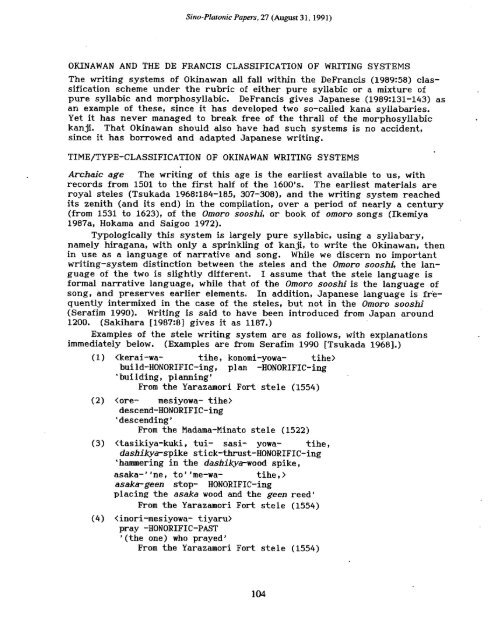Essays on Writing and Language in Honor - Sino-Platonic Papers
Essays on Writing and Language in Honor - Sino-Platonic Papers
Essays on Writing and Language in Honor - Sino-Platonic Papers
Create successful ePaper yourself
Turn your PDF publications into a flip-book with our unique Google optimized e-Paper software.
S<strong>in</strong>o-Plut<strong>on</strong>ic <strong>Papers</strong>, 27 (August 3 1, 199 1)<br />
OKINAWAN AND THE DE FRANCIS CLASSIFICATION OF WRITING SYSTEMS<br />
The writ<strong>in</strong>g systems of Ok<strong>in</strong>awan all fall with<strong>in</strong> the DeFrancis (1989:58) clas-<br />
sificati<strong>on</strong> scheme under the rubric of either pure syllabic or a mixture of<br />
pure syllabic <strong>and</strong> morphosyllabic. DeFrancis gives Japanese (1989:131-143) as<br />
an example of these, s<strong>in</strong>ce it has developed two so-called kana syllabaries.<br />
Yet it has never managed to break free of the thrall of the morphosyllabic<br />
kanji. That Ok<strong>in</strong>awan should also have had such systems is no accident,<br />
s<strong>in</strong>ce it has borrowed <strong>and</strong> adapted Japanese writ<strong>in</strong>g.<br />
TIME/TYPE-CLASSIFICATION OF OKINAWAN WRITING SYSTEMS<br />
Archaic age The writ<strong>in</strong>g of this age is the earliest available to us, with<br />
records from 1501 to the first half of the 1600's. The earliest materials are<br />
royal steles (Tsukada 1968:184-185, 307-308), <strong>and</strong> the writ<strong>in</strong>g system reached<br />
its zenith (<strong>and</strong> its end) <strong>in</strong> the compilati<strong>on</strong>, over a period of nearly a century<br />
(from 1531 to 1623), of the Omoro sooshi, or book of omoro s<strong>on</strong>gs (Ikemiya<br />
1987a, Hokama <strong>and</strong> Saigoo 1972).<br />
Typologically this system is largely pure syllabic, us<strong>in</strong>g a syllabary,<br />
namely hiragana, with <strong>on</strong>ly a spr<strong>in</strong>kl<strong>in</strong>g of kanji, to write the Ok<strong>in</strong>awan, then<br />
<strong>in</strong> use as a language of narrative <strong>and</strong> s<strong>on</strong>g. While we discern no important<br />
writ<strong>in</strong>g-system dist<strong>in</strong>cti<strong>on</strong> between the steles <strong>and</strong> the Omoro sooshi, the lan-<br />
guage of the two is slightly different. I assume that the stele language is<br />
formal narrative language, while that of the Omoro sooshi is the language of<br />
s<strong>on</strong>g, <strong>and</strong> preserves earlier elements. In additi<strong>on</strong>, Japanese language is fre-<br />
quently <strong>in</strong>termixed <strong>in</strong> the case of the steles, but not <strong>in</strong> the Omoro sooshi<br />
(Serafirn 1990). <strong>Writ<strong>in</strong>g</strong> is said to have been <strong>in</strong>troduced from Japan around<br />
1200. (Sakihara [1987:8] gives it as 1187.)<br />
Examples of the stele writ<strong>in</strong>g system are as follows, with explanati<strong>on</strong>s<br />
immediately below. (Examples are from Serafim 1990 [Tsukada 19681.)<br />
(1) (kerai-wa- tihe, k<strong>on</strong>omi-yowa- tihe><br />
build-HONORIFIC-<strong>in</strong>g, plan -HONORIFIC-<strong>in</strong>g<br />
'build<strong>in</strong>g, plann<strong>in</strong>g'<br />
From the Yarazamori Fort stele (1554)<br />
(2) <br />
descend-HONORIFIC-<strong>in</strong>g<br />
' descend<strong>in</strong>g'<br />
From the Madama-M<strong>in</strong>ato stele (1522)<br />
(3) (tasikiya-kuki, tui- sasi- yowa- tihe,<br />
dashikyespike stick-thrust-HONORIFIC-<strong>in</strong>g<br />
'hammer<strong>in</strong>g <strong>in</strong> the dashikyawood spike,<br />
asaka-"ne, to"me-wa- tihe, ><br />
asakageen stop- HONORIFIC-<strong>in</strong>g<br />
plac<strong>in</strong>g the asaka wood <strong>and</strong> the geen reed'<br />
From the Yarazamori Fort stele (1554)<br />
(4)

















